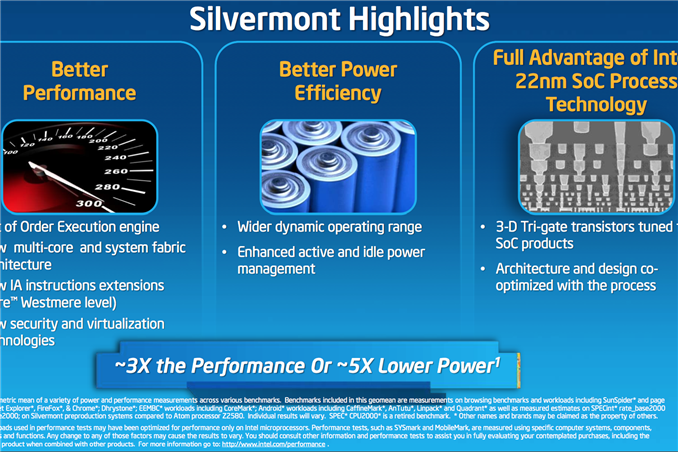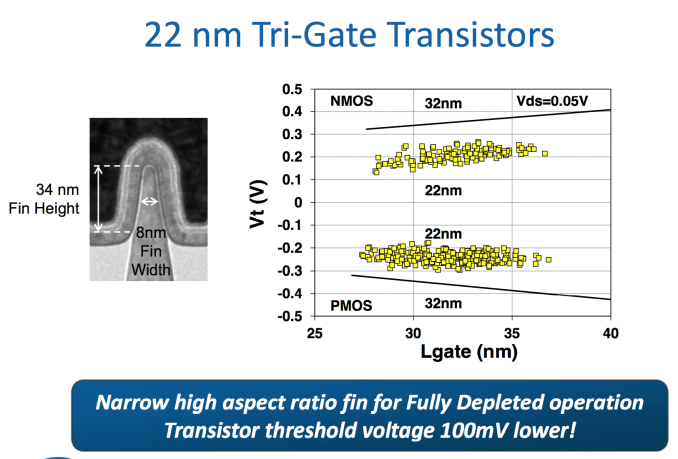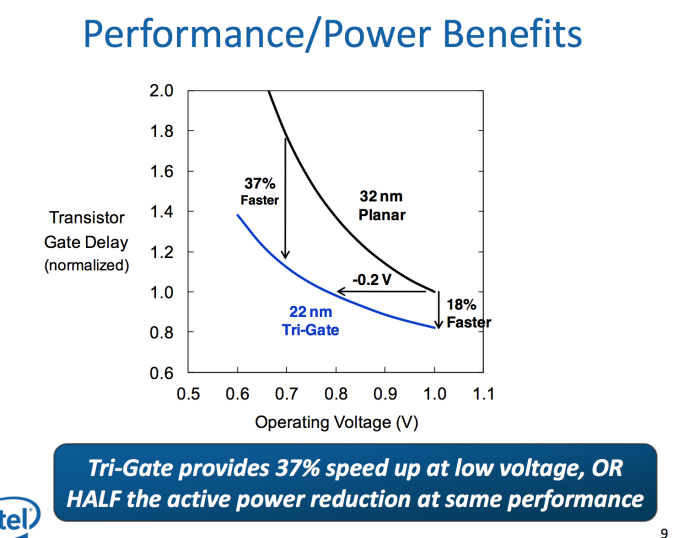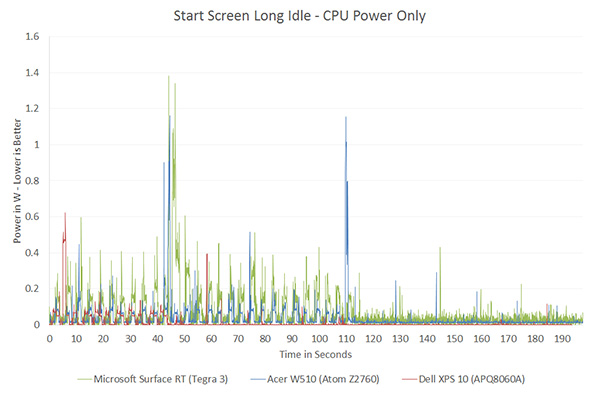Intel’s Silvermont Architecture Revealed: Getting Serious About Mobile
by Anand Lal Shimpi on May 6, 2013 1:00 PM EST- Posted in
- CPUs
- Intel
- Silvermont
- SoCs

The most frustrating part about covering Intel’s journey into mobile over the past five years is just how long it’s taken to get here. The CPU cores used in Medfield, Clover Trail and Clover Trail+ are very similar to what Intel had with the first Atom in 2008. Obviously we’re dealing with higher levels of integration and tweaks for further power consumption, but the architecture and much of the core remains unchanged. Just consider what that means. A single Bonnell core, designed in 2004, released in 2008, is already faster than ARM’s Cortex A9. Intel had this architecture for five years now and from the market’s perspective, did absolutely nothing with it. You could argue that the part wasn’t really ready until Intel had its 32nm process, so perhaps we’ve only wasted 3 years (Intel debuted its 32nm process in 2010). It’s beyond frustrating to think about just how competitive Intel would have been had it aggressively pursued this market.
Today Intel is in a different position. After acquisitions, new hires and some significant internal organizational changes, Intel seems to finally have the foundation to iterate and innovate in mobile. Although Bonnell (the first Atom core) was the beginning of Intel’s journey into mobile, it’s Silvermont - Intel’s first new Atom microarchitecture since 2008 - that finally puts Intel on the right course.
Although Silvermont can find its way into everything from cars to servers, the architecture is primarily optimized for use in smartphones and then in tablets, in that order. This is a significant departure from the previous Bonnell core that was first designed to serve the now defunct Mobile Internet Devices category that Intel put so much faith in back in the early to mid 2000s. As Intel’s first Atom architecture designed for mobile, expectations are high for Silvermont. While we’ll have to wait until the end of the year to see Silvermont in tablets (and early next year for phones), the good news for Intel is that Silvermont seems competitive right out of the gate. The even better news is that Silvermont will only be with us for a year before it gets its first update: Airmont.
 Intel made this announcement last year, but Silvermont is the beginning of Intel’s tick-tock cadence for Atom. Intel plans on revving Atom yearly for at least the next three years. Silvermont introduces a new architecture, while Airmont will take that architecture and bring it down to 14nm in 2014/2015. One year later, we’ll see another brand new architecture take the stage also on 14nm. This is a shift that Intel needed to implement years ago, but it’s still not too late.
Intel made this announcement last year, but Silvermont is the beginning of Intel’s tick-tock cadence for Atom. Intel plans on revving Atom yearly for at least the next three years. Silvermont introduces a new architecture, while Airmont will take that architecture and bring it down to 14nm in 2014/2015. One year later, we’ll see another brand new architecture take the stage also on 14nm. This is a shift that Intel needed to implement years ago, but it’s still not too late.
Before we get into an architectural analysis of Silvermont, it’s important to get some codenames in order. Bonnell was the name of the original 45nm Atom core, it was later shrunk to 32nm and called Saltwell when it arrived in smartphones and tablets last year. Silvermont is the name of the CPU core alone, but when it shows up in tablets later this year it will do so as a part of the Baytrail SoC and a part of the Merrifield SoC next year in smartphones.
22nm
To really understand the Silvermont story, you need to first understand Intel’s 22nm SoC process. Two years ago Intel announced its 22nm tri-gate 3D transistors, which would eventually ship a year later in Intel’s Ivy Bridge processors. That process wasn’t suited for ultra mobile. It was optimized for the sort of high performance silicon that was deployed on it, but not the ultra compact, very affordable, low power silicon necessary in smartphones and tablets. A derivative of that process would be needed for mobile. Intel now makes two versions of all of its processes, one optimized for its high performance CPUs and one for low power SoCs. P1270 was the 22nm CPU process, and P1271 is the low power SoC version. Silvermont uses P1271. The high level characteristics are the same however. Intel’s 22nm process moves to tri-gate non-planar transistors that can significantly increase transistor performance and/or decrease power.
This part is huge. The move to 22nm 3D transistors lets Intel drop threshold voltage by approximately 100mV at the same leakage level. Remember that power scales with the square of voltage, so a 100mV savings depending on what voltage you’re talking about can be very huge. Intel’s numbers put the power savings at anywhere from 25 - 35% at threshold voltage. The gains don’t stop there either. At 1V, Intel’s 22nm process gives it an 18% improvement in transistor performance or at the same performance Intel can run the transistors at 0.8V - a 20% power savings. The benefits are even more pronounced at lower voltages: 37% faster performance at 0.7V or less than half the active power at the same performance.
The end result here is Intel can scale frequency and/or add more active logic without drawing any more power than it did at 32nm. This helps at the top end with performance, but the vast majority of the time mobile devices are operating at very lower performance and power levels. Where performance doesn’t matter as much, Intel’s 22nm process gives it an insane advantage.
If we look back at our first x86 vs. ARM performance data we get a good indication of where Intel’s 32nm process had issues and where we should see tangible improvements with the move to 22nm:
Qualcomm’s 28nm Krait 200 was actually able to get down to lower power levels than Intel could at 32nm. Without having specific data I can’t say for certain, but it’s extremely likely that with Silvermont Intel will be able to drive down to far lower power levels than anything we’ve ever measured.
Understanding what Intel’s 22nm process gives it is really key to understanding Silvermont.













174 Comments
View All Comments
R0H1T - Tuesday, May 7, 2013 - link
Let's see, umm Snapdragon 600 & then there's this soon to be released 800 ? So lemme get this straight, an unreleased product vs one that was available last year, Intel's latest(future indefinite) vs old/dated(relatively) from ARM seems fair to me !ssiu - Monday, May 6, 2013 - link
Exactly the 2 points I wonder about too:(1) GPU performance -- 1/4 of an HD4000, about iPad 4 level -- so slower than e.g. PowerVR Rogue which should come out around the same time
(2) more importantly, even if Intel can make competitive/superior product, can it survive on such low margin?
zeo - Wednesday, May 8, 2013 - link
Well, yes and no on point 1... The iPad is using a quad SGX544, and Rogue doesn't improve performance by that massive amount that a single Rogue/Series 6 could beat a quad Series 5. So it's not that Rogue will be better than the Bay Trail GMA but can scale higher with a multiple configuration!On the margins, Intel is lowering their costs moving to 22nm FAB and despite the declining PC market they're still doing well and so should be fine for the foreseeable future... They'll have to do terribly in all markets to really start hurting now and that's not likely yet...
andrewaggb - Monday, May 6, 2013 - link
too early to say I think. This atom should be pretty good. if it's both twice as fast as the old atom and uses less power (which I believe is what they are trying to tell us), that's pretty good. It will be competing with 2nd gen a-15 designs or better, so the current performance claims are largely meaningless. GPU performance continues to be an issue, aiming for last years performance is definitely way too low. Fortunately gpu speed can normally be scaled more quickly than cpu speed, but intel seems to consistently underspec on gpu so I doubt they'll do better this time. Unless they go haswell style and have various different gpu skus. guess we'll see.Considering how much success rambus has had suing everybody I think if intel wanted to they could probably sue anybody working on advanced processor designs without sufficient licensing arrangements. Drive the minimum cost up a bit so the margins are higher.
R0H1T - Tuesday, May 7, 2013 - link
This comment is hilarious ~ "gpu speed can normally be scaled more quickly than cpu speed" that's only if you're packing moar cores i.e. like SNB<IVB<<Haswell !GPU's cannot be scaled for performance unless there's some major redesigns of the underlying architecture, like AMD's transition to GCN, so unless you've got some insider info into how Intel plans to use their superior Iris(Pro) graphics in Silvermont I see this myth, about Intel's superior graphics, of yours being busted yet again, only this time in the mobile arena !
ominobianco - Monday, May 6, 2013 - link
If you had actually read the article you would know that they are comparing against performance PROJECTIONS of competitors parts available at product launch time, NOT current parts.zeo - Wednesday, May 8, 2013 - link
Sorry but ARMv8 64bit aren't coming out till the later half of 2014 at the earliest and they're pushing to be on 16nm and not 20nm, which may delay them further!While there's no major improvements planned for ARM until then! Many of the original Cortex A15 SoC releases have been delayed from 2012 to 2013!
MrSpadge - Monday, May 6, 2013 - link
Error: On page 1 you correctly write "Remember that power scales with the square of voltage". Almost immediately followed by "At 1V, Intel’s 22nm process gives ... or at the same performance Intel can run the transistors at 0.8V - a 20% power savings."Ouch - forgot that square!
dusk007 - Monday, May 6, 2013 - link
I thought we would wait for 14nm for Intel to definitely pull ahead. This looks very promising.Now my perfect smartphone would sport a dual core Silvermont with a 4000mah battery, the HTC One camera and otherwise durable.
GPU I don't care as long as it is good enough for the GUI I don't play games that would require something fast. Thin? Not at the cost of a smaller battery.
I would love some feature phone like battery life. Triple what we have to deal with now would be incredible and possible it seems to me. Maybe the Motorola Phone X x86 Version can deliver that.
Camera is secondary and I don't need a 1080p screen. Just 4.3-4.5" of 720p and long battery life.
I feel like battery life is where this new generation can really promise new things. 32nm Atom already does really well in the tablets compared to quad core ARM competition. It will be a waste if they add 1500mah batteries though. I hope they finally realize as smartphones are mainstream that a lot of people would care first about battery life and second about 7mm thinness.
beginner99 - Tuesday, May 7, 2013 - link
Agree. Current phones are too big, 1080p is pretty much useless and wastes battery life and even the GPU in Medfield is good enough for the GUI. The lower screen resolution of course helps too with needing a not so good GPU. But with both you save on power. I want a phone I need to charge once a week not every day.